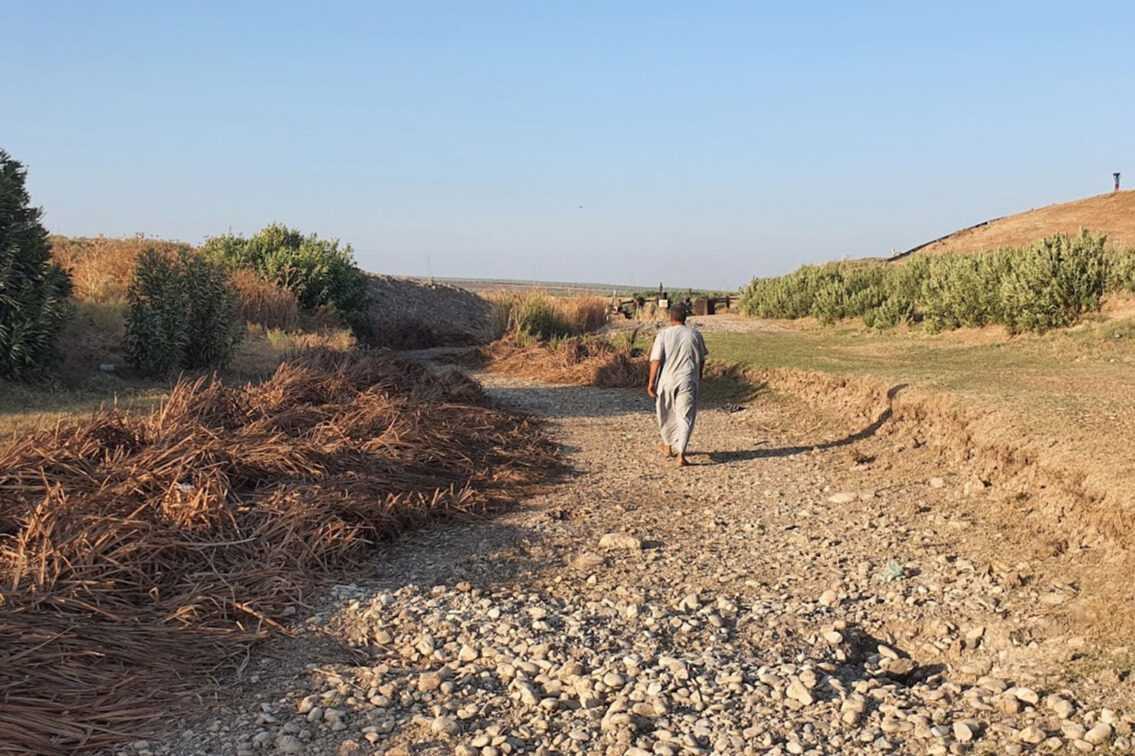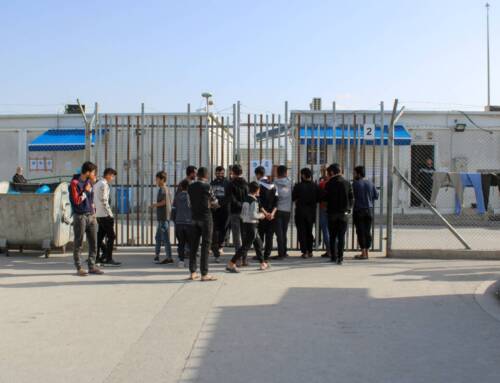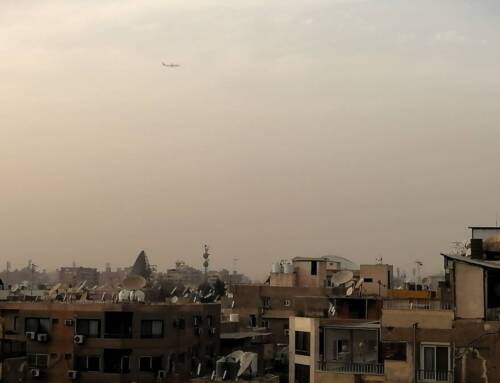Farmers ‘ruined’ as earthquake and climate change leave Afrin River dry
Farmers who rely on the Afrin River to irrigate their crops suffer heavy losses after the river ran dry this summer due to factors related to the February 6 earthquake and a changing climate.
17 September 2023
AFRIN — A dry riverbed runs along farmer Khaled al-Aboud’s land in the Afrin countryside of northern Aleppo. “We’re ruined,” he said. “We’re on the brink of disaster.” The Afrin River, which he and other farmers rely on to sustain their crops, ran dry in July.
Al-Aboud, 49, came to the Afrin-area village of Deir Balout in 2019. He left his home and farmland in the northern Hama countryside behind when the Syrian regime took control. After fleeing north to territory controlled by the Ankara-backed Syrian National Army (SNA), he rented 20 hectares of land with three partners near the town of Mullah Khalil, southwest of Jenderes city. There, they grew summer crops, drawing water from the Afrin River for irrigation.
Over the past four years, the four farmers never had to seek out alternative water sources. But today, with the Afrin River dry for two months, they have decided to drill a well, hoping to “save our remaining crops before losing the entire season, especially since we are currently in the productive stage.”
The Maydanki Dam, officially named the April 17 Dam, lies upstream from the land al-Aboud farms. The lake behind the dam is the main reservoir of water on the Afrin River, which originates in Turkey’s Taurus Mountains, curves through northwestern Syria and reenters Turkey to end in Hatay’s Hamaq (Amik) plain. Some 75 of the river’s 139 kilometers run through Syrian territory.
The 25-megawatt hydroelectric dam, located roughly 12 kilometers northwest of Afrin city, was opened in 2004. It provides drinking water for around 200,000 people, and irrigation water for 30,000 hectares of land.
The February 6, 2023 earthquake that struck southern Turkey and northern Syria impacted the Maydanki Dam, and measures taken in response are one reason the Afrin River has run dry below it—majorly impacting al-Aboud and other farmers in the area.
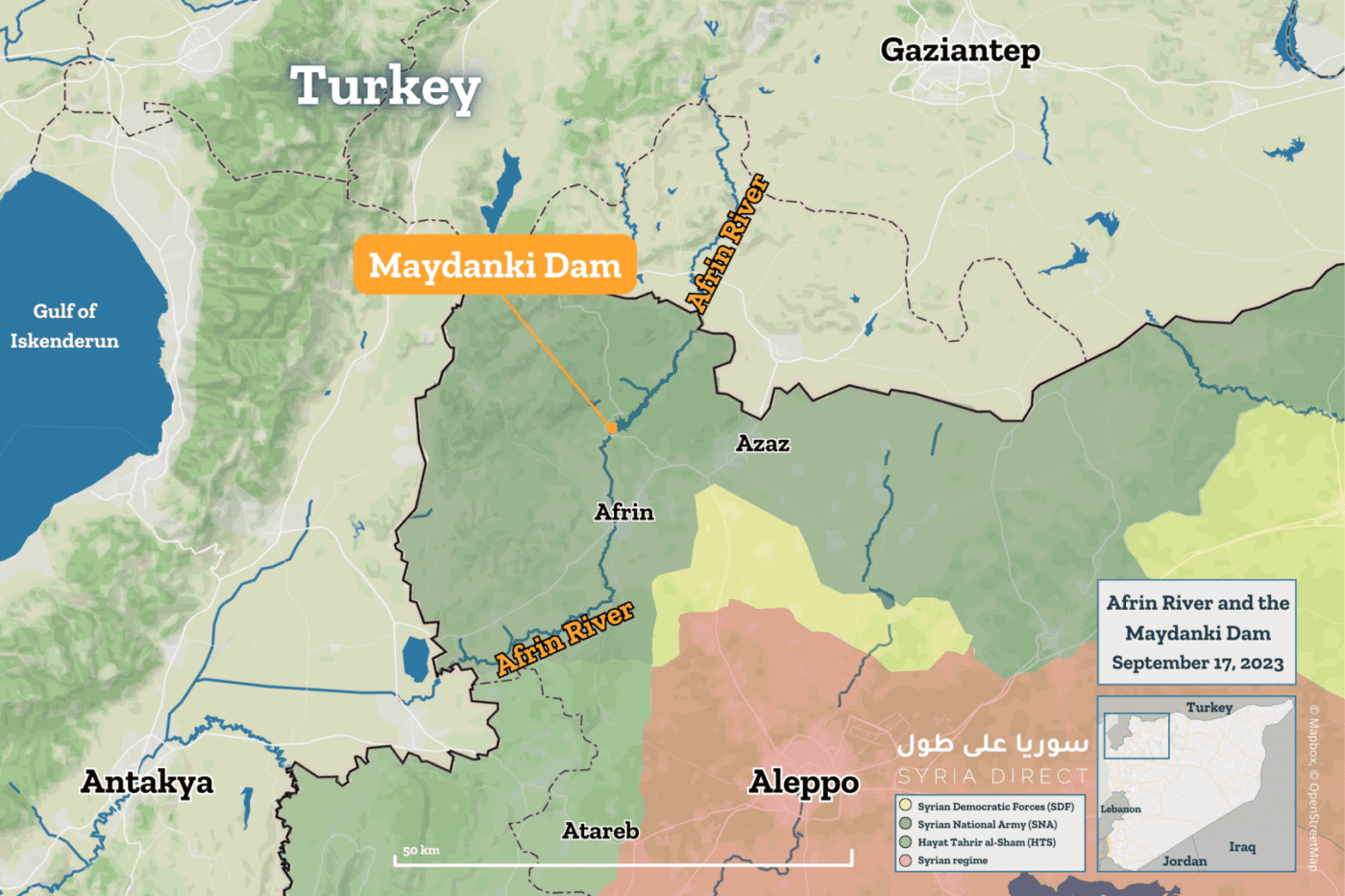
A map of the Afrin River and Maydanki Dam in Syria’s northwestern Aleppo province (Syria Direct)
The earthquake
Following the February 6 earthquake, longitudinal cracks appeared in the top of the Maydanki Dam. Teams of engineers dispatched by the Afrin Local Council assessed the structure, and said the body and gate of the dam were sound and there were no leaks. Still, as a precautionary measure, a portion of the water behind the dam was discharged, reducing the level of the reservoir.
Read more: How did the earthquake affect Syria’s dams and rivers?
In April, the dam’s management and the Ankara-backed Syrian Interim Government’s Olive Branch Chamber of Agriculture “opened the dam to provide irrigation for the first and second wheat crop, while the water was shut off during the harvest season at the start of June,” Suleiman Suleiman, the head of the Chamber of Agriculture, said. This was “an additional factor in the reduction of the dam’s water level.”
The Afrin area is locally referred to as the “Olive Branch region,” named for the early 2017 Turkish military operation against the Kurdish People’s Protection Units (YPG) that saw Ankara-backed opposition factions take control of the area in March of the same year.
With the water level of the reservoir continuing to fall amid an urgent need to provide irrigation water, the Olive Branch Chamber of Agriculture and dam authorities “adopted a four-days-on, four-days-off water rationing plan from late July to mid-September,” Suleiman said.
The rationing plan is based on the level of water in the Maydanki Lake, which authorities divide into three categories. The minimum water level is the amount of water that must be maintained to preserve the structural integrity of the dam, even if it means cutting off drinking water. The second level is the amount of water needed to provide drinking water to villages and towns in the Afrin and Azaz subdistricts. The third and highest level is the amount of water needed for irrigation.
After the February 6 earthquake, the water level fell below the amount needed for irrigation, and threatened to fall below the amount needed to provide drinking water, Suleiman said.
As water supplies dwindled, farmers began “digging holes or creating earthen barriers in the riverbed to collect the water that reaches them during the pumping period to ensure there is enough water for their crops, which has made the problem worse,” Suleiman said. “The Olive Branch Chamber of Agriculture cannot fill these holes because of how many there are.”
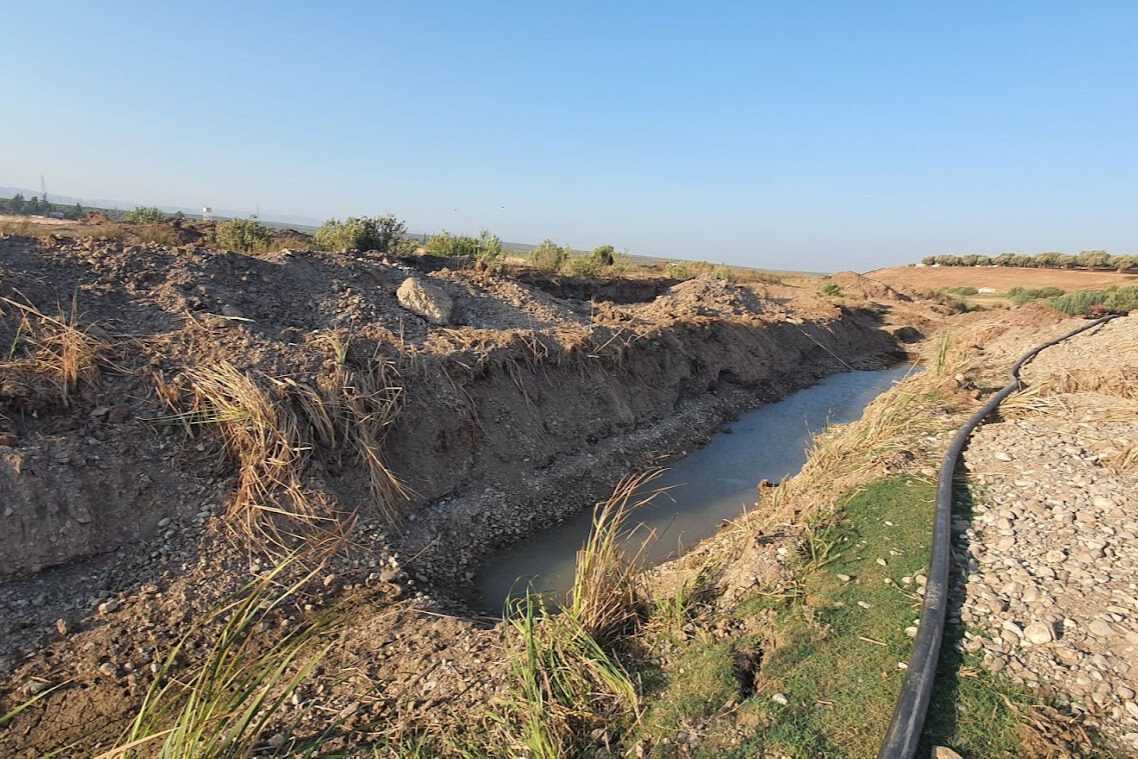
A hole dug by a farmer to collect water in the Afrin River bed, 19/8/2023 (Mahmoud Hamza/Syria Direct)
Limiting loss
On their 20 hectares of land, al-Aboud and his partners grow peanuts, watermelon, molokhia and yellow corn. To minimize their losses after the river ran dry, they chose to stop watering four hectares of peanuts, two hectares of molokhia and two hectares of yellow corn, prioritizing the rest of their crops—including five hectares of watermelon.
To secure water, al-Aboud “dredged depressions in the riverbed, using an excavator that rents for $35 an hour, to collect excess water from the irrigation of neighboring land or the moisture of the ground,” he said. It is an emergency measure, one that provides varying amounts of water for the farmers to irrigate their crops for two hours in the morning and two in the evening.
Farmers in the area have also begun to dig artesian wells—which bring groundwater to the surface using natural pressure rather than pumping—without obtaining permits from local councils.
Ahmad al-Jadoua, a farmer who was also displaced from al-Aboud’s hometown of Kafr Zeita, recently dug a 400-meter artesian well at a cost of $15,000. But the flow rate of the completed well is below what he needs to irrigate his five hectares of peanut crops.
Land along the Afrin River rents for a higher price than other parts of Afrin—ranging between $1,500 and $1,900 per year because it “can be irrigated directly from the river, at lower costs than lands that rely on artesian wells,” al-Aboud said. Without the river water, farmers are paying more while also taking on additional expenses to secure water.
Al-Aboud estimated that he and his partners have lost around $25,000 so far due to the lack of water. Their actual losses from lost crops are $13,000, while the artesian well they are drilling costs $12,000. Al-Aboud hopes they can “save what can be saved from the season and recover part of the capital invested in the land: $80,000.”
Farmers are not the only ones suffering losses due to the dry Afrin River, which is also impacting workers who support the agricultural sector. July, August and September are “peak months for farmers and agricultural pharmacies, since it’s the production period for cucumber, zucchini and watermelon crops,” and potato planting starts in August, Abdul Moeen al-Naasan, who owns an agricultural supply store in the Aleppo countryside town of Tal Salour, told Syria Direct.
Without enough water, “there won’t be movement in the sale of fertilizers, pesticides and other agricultural supplies,” he added. These days, al-Naasan’s daily sales barely reach $30, while at the same time last year he made daily sales of $100-$140, he said.
Suleiman, from the Olive Branch Chamber of Agriculture, estimated that the total area of land planted with irrigated crops on the banks of the Afrin River—from the Maydanki Dam to the Syrian-Turkish border—is around 20,000 hectares. Around 6,000 hectares are not receiving enough water, he said.
“Around 70 percent of summer crop farmers” were impacted, he added, “making up 30 percent of the total number of farmers in the Olive Branch area.”
Climate change
Between Tal Salour south of Jenderes and Mullah Khalil on the Turkish border, the Afrin River began to dry in mid-June and completely dried in July. Meanwhile, accessing irrigation water requires “digging wells to a depth of more than 400 meters,” agricultural technician al-Naasan said.
The latest water shortage in Afrin is part of a broader climate crisis across Syria. The country’s northwest is facing “a decline in vegetation cover such as woods and forests due to fires, grazing and logging, exacerbating climate change that appeared in the form of successive, severe heat waves,” engineer Anas al-Rahmoun, a climate and environment activist, said.
Read more: ‘Crimes against nature’: Forest clearing around Afrin’s Maydanki Lake sparks anger and shock
Al-Rahmoun pointed to “the latest heat wave starting on August 13, which lasted for six days with the maximum temperature reaching 47 degrees Celsius due to the heat dome effect.”
Surface water is also directly affected by low rainfall, and precipitation has declined significantly over the past decade, al-Rahmoun said. Rainfall levels in the Olive Branch area fell to 225 millimeters last winter, compared to 400 millimeters the year before, Suleiman added.
This year is not the first time that the Afrin River’s water level has fallen or that the waterway has partially dried up. In the 2007-2008 season, Afrin—like the rest of Syria—experienced a wave of drought due to a decrease in snow and rainfall and an increase in temperature levels, Suleiman said.
With the Afrin River dry, none of the solutions available to al-Aboud will fully compensate him for his loss this year. Even the well he and his partners are paying $12,000 for is being drilled into rented land. If the land returns to its original owner, the well will go with it.
What he hopes for now is to make it through this season with the least amount of damage possible—to save what can still be saved.
**
This report was originally published in Arabic and translated into English by Mateo Nelson.

